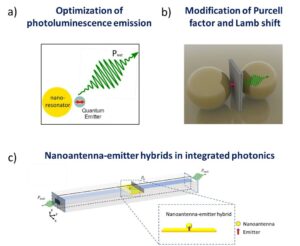M. Zapata-Herrera
Donostia International Physics Center (DIPC), Donostia-San Sebastián, Spain.
Optical nanoantennas are nanostructures that strongly interact with light through the excitation of localized surface plasmonic resonances. These resonances result from the collective oscillations of free electrons within the metal, generating enhanced electromagnetic fields in subwavelength volumes. This phenomenon has been exploited in numerous applications in nanophotonics, including enhanced spectroscopy, sensing, and imaging.
Notably, plasmonic nanoantennas can serve as a versatile platform for controlling the efficiency of light emission and the optical properties of single emitters (such as organic molecules, quantum dots, or nitrogen-vacancy centers in nanocrystals) by modifying their electromagnetic environment.
In this talk, I will present a comprehensive theoretical study on how plasmonic nanoantennas can be designed to tailor and optimize the light emission of single quantum emitters such as organic molecules, quantum dots, and nitrogen-vacancy centers (see Figure 1). Specifically, I will discuss three key aspects:
i) how single and coupled plasmonic nanoantennas of various geometries modify the photoluminescence of emitters by altering the local density of photonic states. These include single and dimer gold nanorod antennas, plasmonic nanocavities, patch nanoantennas, and hybrid photonic-plasmonic cavities (Figure 1a) [1-4];
ii) how the emission spectra from a single molecule can be tailored by placing it within a plasmonic nanocavity formed by a gold nanodimer deposited on a mirror substrate, which radically alters the local photonic environment and introduces a very large Purcell Factor and Lamb Shift (Figure 1b) in excellent agreement with experimental results using DNA-origami–positioned emitters [5]; and
iii) how integrating such antenna–emitter hybrids with dielectric waveguides, such as SiN platforms, enables efficient coupling of nanoscale emission into photonic circuits [6,7] (Figure 1c).
Altogether, this work outlines a systematic approach for controlling light–matter interaction at the nanoscale, providing design guidelines for efficient, tunable, and integrable light sources for future nanophotonic and quantum technologies.
In this talk, I will present a comprehensive theoretical study on how plasmonic nanoantennas can be designed to tailor and optimize the light emission of single quantum emitters such as organic molecules, quantum dots, and nitrogen-vacancy centers (see Figure 1). Specifically, I will discuss three key aspects:
i) how single and coupled plasmonic nanoantennas of various geometries modify the photoluminescence of emitters by altering the local density of photonic states. These include single and dimer gold nanorod antennas, plasmonic nanocavities, patch nanoantennas, and hybrid photonic-plasmonic cavities (Figure 1a) [1-4];
ii) how the emission spectra from a single molecule can be tailored by placing it within a plasmonic nanocavity formed by a gold nanodimer deposited on a mirror substrate, which radically alters the local photonic environment and introduces a very large Purcell Factor and Lamb Shift (Figure 1b) in excellent agreement with experimental results using DNA-origami–positioned emitters [5]; and
iii) how integrating such antenna–emitter hybrids with dielectric waveguides, such as SiN platforms, enables efficient coupling of nanoscale emission into photonic circuits [6,7] (Figure 1c).
Altogether, this work outlines a systematic approach for controlling light–matter interaction at the nanoscale, providing design guidelines for efficient, tunable, and integrable light sources for future nanophotonic and quantum technologies.

Figure 1. Light emitted from single emitters placed in a variety of plasmonic scenarios: a) A quantum emitter in close proximity to a single nanoresonator. b) Fluorophore placed in a plasmonic nanocavity within a nanodimer on a mirror (NDoM) configuration. c) Nanoantenna-emitter coupled to an etched SiN waveguide.
References
1. Montaño-Priede. J. L., et al. “An Overview on Plasmon-enhanced Photoluminescence via Metallic Nanoantennas”. Nanophotonics, 13(26): 4771–4794, 2024.
2. Gupta. V., et al. Emission Enhancement of Colloidal Quantum Dots Confined in Double Disc Nano-antennas with Controlled Exposing of the Gap Opening”. In preparation.
3. Barreda, A. I., et. al. Hybrid Photonic-Plasmonic Cavities Based on the Nanoparticle-on-a-Mirror Configuration. Photonics Res. 9 (12), 2398, 2021.
4. Barreda, A. I., et. al. Hybrid Photonic-Plasmonic Cavity Design for Very Large Purcell Factors at Telecommunication Wavelengths. Phys. Rev. Appl. 18 (4), 044066, 2022
5. Verlekar, S., et al. Giant Purcell broadening and Lamb shift for DNA-assembled near-infrared quantum emitters. ACS Nano, 19, 3, 3172–3184, 2025.
6. de Aberasturi, et al. Modern Applications of Plasmonic Nanoparticles: From Energy to Health. Adv. Opt. Mater, 3 (5), 602–617, 2015.
7. Zapata-Herrera, M. et al. Design Strategies to Optimize Light Emission from Plasmonic Antenna-Emitter Hybrids into Waveguides. In preparation.
1. Montaño-Priede. J. L., et al. “An Overview on Plasmon-enhanced Photoluminescence via Metallic Nanoantennas”. Nanophotonics, 13(26): 4771–4794, 2024.
2. Gupta. V., et al. Emission Enhancement of Colloidal Quantum Dots Confined in Double Disc Nano-antennas with Controlled Exposing of the Gap Opening”. In preparation.
3. Barreda, A. I., et. al. Hybrid Photonic-Plasmonic Cavities Based on the Nanoparticle-on-a-Mirror Configuration. Photonics Res. 9 (12), 2398, 2021.
4. Barreda, A. I., et. al. Hybrid Photonic-Plasmonic Cavity Design for Very Large Purcell Factors at Telecommunication Wavelengths. Phys. Rev. Appl. 18 (4), 044066, 2022
5. Verlekar, S., et al. Giant Purcell broadening and Lamb shift for DNA-assembled near-infrared quantum emitters. ACS Nano, 19, 3, 3172–3184, 2025.
6. de Aberasturi, et al. Modern Applications of Plasmonic Nanoparticles: From Energy to Health. Adv. Opt. Mater, 3 (5), 602–617, 2015.
7. Zapata-Herrera, M. et al. Design Strategies to Optimize Light Emission from Plasmonic Antenna-Emitter Hybrids into Waveguides. In preparation.
